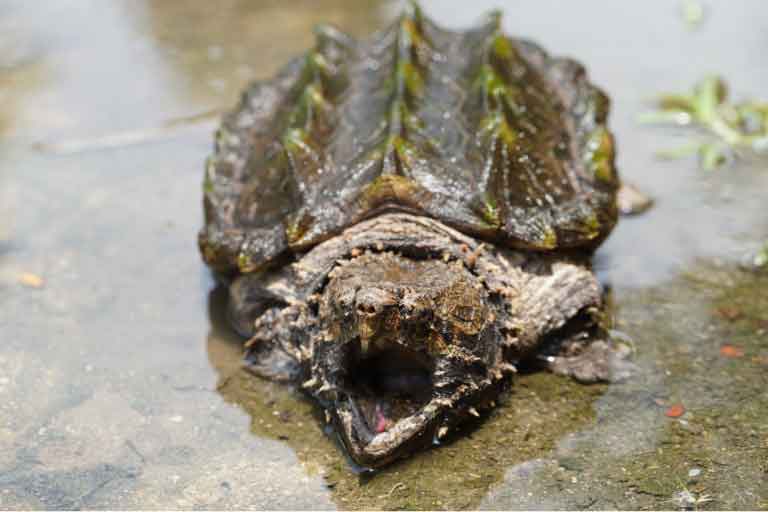Why Is My Turtle Always Hungry? | Feeding Tips & What You Should Do
Imagine finding your beloved turtle flipped upside down, legs flailing helplessly—panic sets in as you wonder if they can get back up or if they’re in serious danger! As a turtle owner who’s seen my own pets in this predicament, I know how stressful it is to question whether your shelled friend can right themselves…
Imagine finding your beloved turtle flipped upside down, legs flailing helplessly—panic sets in as you wonder if they can get back up or if they’re in serious danger!
As a turtle owner who’s seen my own pets in this predicament, I know how stressful it is to question whether your shelled friend can right themselves or if being upside down could harm them.
In this post, I’ll share my experiences and insights to help you understand if turtles can flip themselves over, the risks of being stuck, and how you can step in to save the day.
Keep reading to learn how to keep your turtle safe and what to do if you find them in a flip!
Can Turtles Flip Themselves Over?
Turtles are fascinating creatures, and their ability to flip themselves over depends on a few factors, like their species, size, and the environment they’re in. I’ve seen my own turtles—box turtles, sliders, and even a sulcata—get themselves into some awkward positions, and it’s always a mix of impressive and nerve-wracking to watch them try to right themselves.
Most turtles have a natural instinct to get back on their feet. They’ll stretch out their legs, twist their necks, and use their strong limbs to push against the ground or nearby objects to flip over. Smaller turtles, like red-eared sliders or painted turtles, are often more agile and can flip themselves over with relative ease. I’ve watched my red-eared slider, Toby, wriggle like a little gymnast to get back upright after a tumble. Their lighter shells and flexible bodies make it easier to maneuver.
However, larger turtles, like tortoises or species with high-domed shells, might struggle more. My sulcata, Big Bertha, once got flipped during an ambitious climb over a rock in her enclosure. Her heavy shell and short legs made it tough for her to roll back over without some help. The shape of the shell plays a big role too—flatter shells are easier to flip than tall, rounded ones.
Factors That Affect Flipping Ability
Here’s what I’ve learned about what influences a turtle’s ability to right itself:
- Species and Shell Shape: Aquatic turtles, like sliders or cooters, often have flatter, streamlined shells that make flipping easier. Terrestrial tortoises with domed shells, like Russian tortoises, may find it harder.
- Size and Weight: Smaller, lighter turtles have an advantage. Larger turtles carry more weight, which can make flipping a bigger challenge.
- Environment: A smooth surface, like a tiled floor, offers less grip for a turtle to push against compared to a rough, natural terrain with rocks or plants. I’ve noticed my turtles do better in their outdoor pen where they can use the ground texture to their advantage.
- Health and Strength: A healthy turtle with strong limbs and good muscle tone is more likely to flip itself over. If your turtle is weak, injured, or elderly, it might struggle more.
In my experience, most turtles can eventually flip themselves over if they’re healthy and have something to push against. But if they’re stuck for too long, it can lead to serious problems—which brings us to the next big question.
What Happens When a Turtle Is Stuck Upside Down?
Seeing a turtle on its back can be distressing, and I’ve had my heart skip a beat a few times when one of my turtles ended up in this predicament. Being upside down isn’t just uncomfortable for a turtle—it can lead to serious health issues if they stay that way too long. Let’s break down what happens to a turtle when it’s stuck on its back and why time is of the essence.
Why Being Upside Down Is Dangerous
When a turtle is flipped over, its body is in an unnatural position, and several things can go wrong:
- Breathing Difficulties: Turtles rely on their muscles to help them breathe, and being upside down can compress their lungs, making it harder to get enough oxygen. I noticed this with my box turtle, Sheldon, when he got stuck once—his breathing seemed labored until I helped him back over.
- Stress and Panic: Turtles can become incredibly stressed when they can’t right themselves. This stress can weaken their immune system over time, making them more susceptible to illness.
- Exposure to Elements: In the wild or an outdoor enclosure, an upside-down turtle is vulnerable to predators, extreme heat, or dehydration. I’ve seen how quickly the sun can overheat my turtles if they’re not in a shaded spot, and being upside down makes it worse.
- Organ Pressure: For larger turtles, the weight of their body pressing against their organs can cause discomfort or even damage if they’re stuck for hours. This is especially true for tortoises like my sulcata, Big Bertha, whose hefty shell adds extra pressure.
Can a Turtle Die from Being Upside Down?
Yes, a turtle can die from being upside down, but it’s not an instant death sentence. The risk depends on how long they’re stuck, their health, and the environment. For example, if a turtle is left upside down in direct sunlight, it can overheat quickly, leading to heatstroke or death within hours. I’ve read heartbreaking stories from other turtle owners who found their pets too late after they’d been stuck in the hot sun.
Aquatic turtles face an additional risk. If they flip over in water and can’t right themselves, they could drown. I had a close call with my red-eared slider, Toby, who got wedged upside down between some rocks in his tank. Thankfully, I caught it in time, but it was a reminder of how dangerous water can be for a flipped turtle.
How Long Can a Turtle Survive Upside Down?
The survival time varies. A healthy turtle in a cool, shaded environment might survive for several hours or even a day, though it’ll be stressed and uncomfortable. In harsh conditions—like intense heat or water—things can go south much faster, sometimes within an hour. I always check on my turtles regularly, especially after rearranging their enclosure, to make sure they haven’t gotten into a flip they can’t handle.
Signs Your Turtle Needs Help
If you see your turtle upside down, don’t assume it’ll flip itself over right away. Here are some signs I look for to know when intervention is needed:
- Prolonged Struggling: If your turtle is flailing its legs and neck but not making progress after a few minutes, it’s time to step in.
- Lethargy: If it stops moving or seems weak, it might be exhausted or in distress.
- Abnormal Breathing: Gasping or irregular breathing is a red flag that your turtle is struggling to breathe properly.
- Environmental Risks: If it’s in direct sun, water, or a cramped space, act quickly to prevent harm.
In my years of keeping turtles, I’ve learned that a quick check-in can make all the difference. If you’re not sure whether your turtle needs help, it’s better to err on the side of caution and assist them.
How to Help a Turtle Flip Over Safely
If you find your turtle stuck on its back, don’t panic—but do act quickly. I’ve had to rescue my turtles a few times, and I’ve learned the best ways to help without causing them more stress or harm. Here’s how you can safely assist your turtle and prevent future flips.
Steps to Help a Flipped Turtle
- Assess the Situation: Before you touch your turtle, check its surroundings. Is it in water, direct sunlight, or a safe spot? If it’s in danger (like overheating or drowning), act immediately. I once found my box turtle, Sheldon, upside down in his outdoor pen on a hot day, and I knew I had to move fast to get him out of the sun.
- Approach Gently: Turtles can get stressed if you grab them suddenly. Approach from the side or behind, and avoid making loud noises. I always talk softly to my turtles to keep them calm.
- Gently Flip Them: Place one hand on the side of the shell and carefully roll the turtle back onto its feet. Don’t pull on its legs or head, as this can cause injury. With my sulcata, Big Bertha, I had to use both hands because of her weight, but a gentle nudge was enough to get her upright.
- Check for Injuries: After flipping, look for signs of distress, like lethargy, labored breathing, or visible injuries. If anything seems off, consult a vet. I always give my turtles a quick once-over to make sure they’re okay after a flip.
- Monitor Their Behavior: Keep an eye on your turtle for a few hours to ensure they’re eating, moving, and acting normally. When Toby, my slider, got stuck once, he was a bit sluggish afterward, so I gave him some extra soak time to help him recover.
Tips to Prevent Turtles from Flipping Over
To keep your turtle from ending up on its back in the first place, here are some tips I’ve found helpful:
- Create a Safe Environment: Ensure their enclosure is free of steep climbs or objects they can tip over on. I removed some risky rocks from Big Bertha’s pen after her flipping incident.
- Provide Proper Space: Aquatic turtles need enough water depth to swim and dive comfortably, while terrestrial turtles need flat, stable ground. My sliders thrive in a 50-gallon tank with plenty of room to maneuver.
- Avoid Overcrowding: If you have multiple turtles, make sure there’s enough space to prevent them from climbing over each other, which can lead to flips. I learned this the hard way when my two sliders started jostling for basking spots.
- Regular Check-Ins: Especially for outdoor enclosures, check on your turtles daily to catch any issues early. I make it a habit to do a quick scan of my turtle pens every morning.
FAQs
1. Can All Turtles Flip Themselves Over?
Not all turtles can flip themselves over easily. Smaller, lighter turtles with flatter shells, like red-eared sliders, are usually better at it. Larger tortoises with domed shells, like sulcatas, may struggle more. It also depends on their health and environment.
2. How Long Can a Turtle Stay Upside Down Before It’s Dangerous?
It varies, but a healthy turtle in a cool, shaded area might be okay for a few hours. In harsh conditions like direct sunlight or water, they can be at risk within an hour. Always check on your turtle regularly to be safe.
3. Should I Always Help a Flipped Turtle?
If your turtle is struggling for more than a few minutes or is in a dangerous environment (like water or heat), help them immediately. If they seem to be working on flipping themselves and are in a safe spot, give them a little time but keep an eye on them.
Final Words
Turtles are resilient creatures, but seeing them upside down can be a real wake-up call. Most turtles can flip themselves over with enough effort, but factors like their size, shell shape, and environment play a big role. Being stuck on their back isn’t just uncomfortable—it can be life-threatening if left too long, especially in extreme conditions. By understanding their needs and keeping their enclosure safe, you can help your shelled buddy avoid these situations. And if you do find them flipped, now you know how to step in like a turtle-saving hero! Keep an eye on your pets, give them the care they deserve, and you’ll both enjoy many happy years together.







